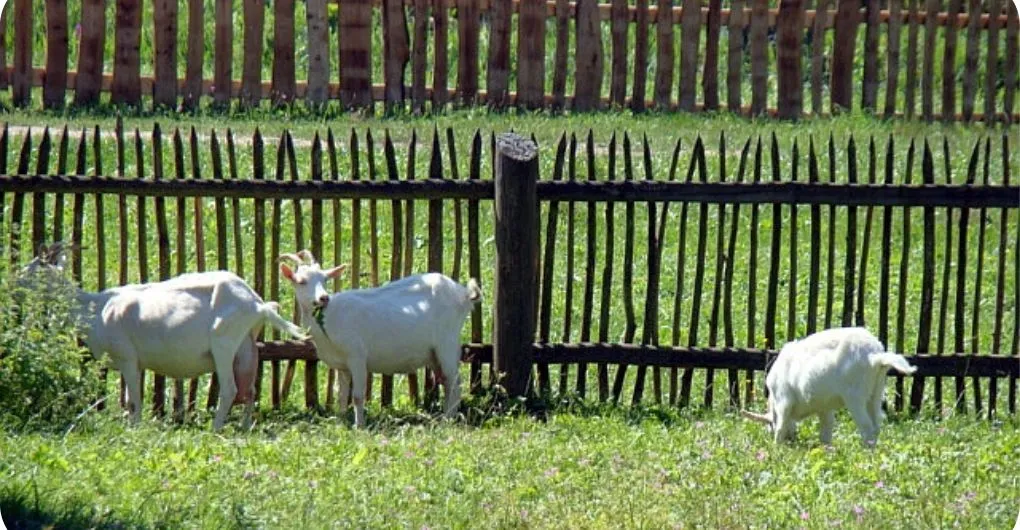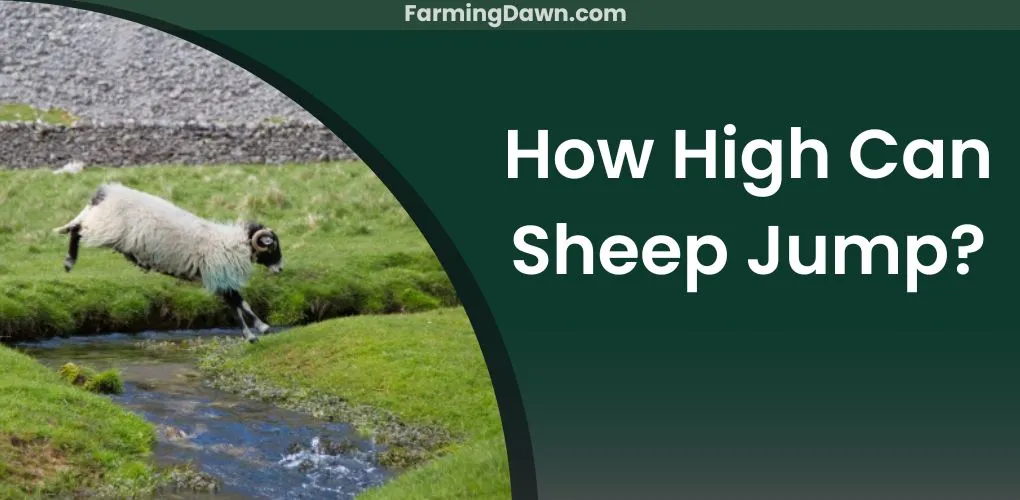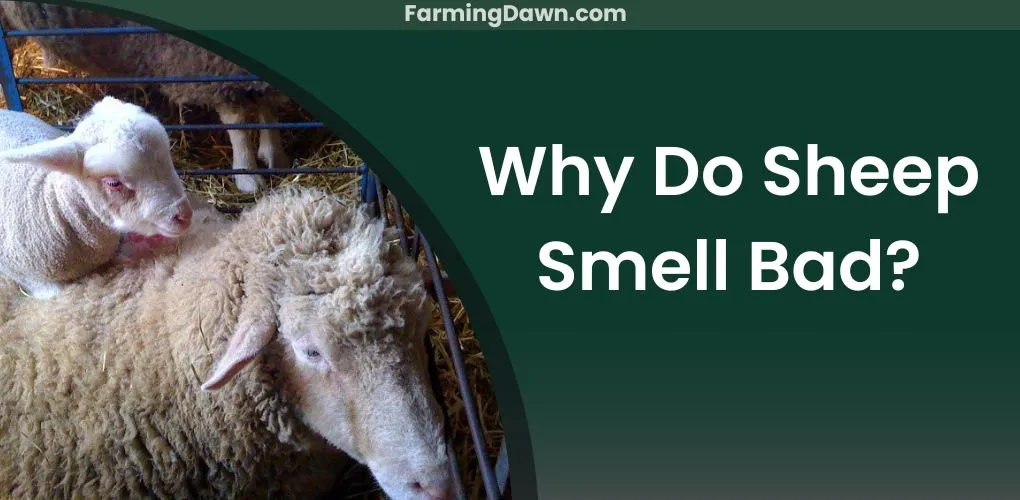Sheep may not be the first animal that comes to mind when you think of high jumpers, but they’re no slouches in that department. These woolly creatures are known for their docile nature, but don’t let that fool you. When it comes to jumping, they can surprise you with their athleticism. So, just how high can sheep jump? Today, I will explore the diverse topic of sheep jumping and cover just how high sheep can jump and why they might need to.
How High Can Sheep Jump? Sheep Jumping Ability
How High can an Average Sheep Jump?
Sheep are remarkable animals with impressive jumping ability. The average sheep jumping height is about 3 to 4 feet. However, some sheep breeds are known to jump even higher, up to 6 feet, with the record being 6 feet and 7 inches. This amazing ability allows them to clear obstacles such as fences and rocks, making them efficient grazers in diverse landscapes.
Factors That Affect Sheep Jumping Ability
Several factors affect sheep jumping ability. These factors are:
- Breed of sheep
Different sheep breeds have different physical characteristics that influence their jumping ability. For instance, some breeds have longer legs and stronger muscles, enabling them to jump higher than others. While some Sheep breeds such as Babydoll sheep are smaller in size have low jumping ability, as compared to Targhee Sheep.
- Age of sheep
The age of a sheep also plays a role in its jumping ability. Younger sheep tend to jump higher than older ones, as they are more agile and energetic.
- Health and fitness of sheep
Moreover, the health and fitness of sheep affect their jumping ability. A well-fed, healthy, and fit sheep is more likely to jump higher than a malnourished, sick, or unfit one. It is essential to provide sheep with adequate nutrition, clean water, and proper care to maintain their health and fitness.
Comparison of Sheep Jumping Ability to Other Animals
When it comes to comparing sheep jumping ability to other animals, sheep are not the best jumpers. For example, deer, gazelles, and mountain goats are known to jump much higher and farther than sheep. Nevertheless, sheep’s jumping ability is still impressive, given their body size and weight.
Why Do Sheep Jump?
Sheep Jump Because of instincts
In the wild, sheep have to navigate a rugged and challenging terrain to escape predators. Jumping is an essential skill for them to survive. They can jump over obstacles like rocks, bushes, and even streams to evade predators like wolves, coyotes, and mountain lions. This ability helps them stay alive and preserve their species.
How sheep jumping benefits them in the wild
Jumping also benefits sheep by allowing them to reach food sources that are out of reach on the ground. In the wild, sheep graze on grass, herbs, and other plants that grow in rocky, hilly, or mountainous terrain. Jumping enables them to reach the plants that are on higher ground and not accessible by grazing on foot.
Domestication of sheep and how jumping ability has changed
Now, let’s talk about the domestication of sheep and how their jumping ability has changed. Domesticated sheep have evolved to meet the needs of human beings. Their physical traits, including their jumping ability, have changed as well. Sheep breeds that are raised for wool or meat have been selectively bred to be less agile and more docile. They don’t need to jump as high or as often as their wild ancestors because they are protected and cared for by humans.
However, some sheep breeds, like the Border Collie and the Australian Kelpie, are still bred for their herding and agility skills. These breeds are highly athletic and can jump over fences and other obstacles with ease. They are also intelligent and can learn complex commands and instructions. High-jumping sheep are also used in sheep jumping competitions. I will talk about this competition later in the post.
Do Sheep Jump Fences?
Sheep Can Jump Over Some Fences
Sheep are curious and adventurous animals, and they have been known to jump over some fences. But, the question arises how high can sheep over a fence? To answer, their ability to jump fences depends on the height and type of fence.
For instance, a 3-foot fence is not sufficient to contain a sheep, while a 4 to the 5-foot fence can prevent most sheep from jumping over. Sheep can also jump higher if they have something to lean on, such as a rock or tree stump. Therefore, it is essential to build a fence that is tall enough to keep the sheep safely inside the enclosed area.
The Sheep Should Feel Safe Inside the Fenced Area
I will recommend you ensure that the sheep feel safe and comfortable inside the fenced area. A secure and sturdy fence can provide the sheep with a sense of protection and security, making them less likely to attempt to escape.
Fences should be properly maintained and free of holes or gaps, as these can provide an opportunity for the sheep to escape. Additionally, it is essential to keep the surrounding area free of potential hazards, such as loose wires or sharp objects that can harm the sheep.
What Types of Fencing Should You Use?
When it comes to fencing options for sheep, there are several types to choose from. Electric fences are a popular option because they are easy to install and maintain. They also provide a safe and effective way to contain sheep while allowing them to graze freely.
Wooden fences are also a good option, as they are sturdy and durable, but they require more maintenance than electric fences. Other options include wire mesh, barbed wire, and woven wire fencing, but these may not be suitable for all situations.
Can Sheep Jump Over Fences?
I have already explained your question can sheep jump over fences? in the previous section. Sheep jumping over fences depends on the type of fence you have on your property. For example, if you have a high and sturdy fence, then it’s unlikely that your sheep will be able to jump over it. On the other hand, if you have a low or weak fence, then your sheep may be able to jump over it, especially if they’re motivated enough.
Well-maintained fences are crucial to keeping sheep in. If your fence is damaged, your sheep will likely find a way to escape, which can be problematic for you as a farmer. Therefore, it’s important to regularly inspect and repair your fence to ensure its secure enough to keep your sheep in.

Sheep Jump over Fences mostly Before Spring Greens Up
The hardest time to keep sheep in a fence is right before spring greens up. During this time, sheep are hungry and looking for fresh vegetation to eat. If they see a patch of fresh grass on the other side of the fence, they may be more motivated to try and jump over it.
Why would Sheep Jump over a Fence?
It’s important to understand why sheep would jump over a fence. Sheep may try to escape if they feel threatened by predators or if they’re searching for food. Additionally, if a group of sheep is tightly packed, they may be more likely to try and jump over a fence to escape the crowded conditions. So, keep in mind these scenarios, if your sheep are getting out of the fence again and again. As a farmer, it is your responsibility to provide proper care to your livestock.
Sheep Jumping Competitions
Since this article is all about jumping, so I thought of discussing competition for sheep jumping. Sheep jumping competitions are exciting and entertaining sport that involves sheep jumping over hurdles or obstacles. These competitions are popular in many countries, including the United States, Canada, and New Zealand. They provide a unique opportunity to showcase the athleticism and agility of sheep and are a great way to bring together communities.
Rules and regulations
The rules and regulations of sheep jumping competitions are fairly straightforward. Sheep are trained to jump over hurdles, which can be set at varying heights and distances. The sheep must clear the obstacle without knocking it over or getting stuck in the hurdle. Judges score the sheep based on their speed, accuracy, and technique, and the sheep with the highest score wins.
World records and notable achievements
One of the most impressive aspects of sheep jumping competitions is the world records and notable achievements that have been set over the years. In 2015, a sheep named Sweet Pea set the world record for the highest jump, clearing a hurdle that was 3 feet 8 inches tall.
Other notable achievements include the longest jump, set by a sheep named Lucky in 2013, who cleared a distance of 29 feet and 2 inches, and the fastest time, set by a sheep named Speedy in 2016, who cleared the hurdles in just 8.8 seconds.
Significance of These Competitions
Sheep jumping competitions are not just about the competition itself; they also serve as a platform to raise awareness about the importance of animal welfare. Many competitors use the competitions to showcase the relationship between humans and animals and to highlight the benefits of responsible animal husbandry.
Training Your Sheep for Jumping Competitions
If you own sheep then jumping competitions must have made you want to participate in these competitions. But before you take part in these fierce battles, you need to properly train your sheep. Don’t worry, this section will give you a complete overview of raising jumping sheep.
How to Train and Prepare Sheep for Jumping Competitions
To train your sheep for jumping competitions, start by introducing them to obstacles such as poles and jumps. Gradually increase the difficulty of the obstacles to building their jumping skills. You can use positive reinforcement techniques such as treats to encourage your sheep to jump over the obstacles. To prepare your sheep for jumping competitions, make sure they are in good physical condition.
Nutrition and Exercise Requirements for Jumping Sheep
Exercise is also crucial for your jumping sheep. Regularly take them for walks or runs to help build their endurance and strengthen their muscles. You can also set up a jumping course in your pasture or barn to help them practice their jumping skills. Provide them with a balanced diet that includes plenty of high-quality hay and fresh water. You may also want to supplement your diet with protein-rich feeds such as alfalfa or soybean meal.
Common mistakes to Avoid when Raising jumping sheep
When raising jumping sheep, there are common mistakes that you should avoid. One of the most important is overfeeding your sheep, which can lead to obesity and health problems. Another common mistake is not providing enough exercise or opportunities for your sheep to practice jumping. This can lead to poor performance in competitions.
It’s also important to avoid using harsh training methods or punishing your sheep for not jumping correctly. This can lead to stress and anxiety, which can negatively impact their performance and well-being.
Do Sheep Jump When They Are Happy?
When sheep are feeling happy and playful, they will sometimes leap into the air and jump around. It’s a sign that they are feeling good and enjoying their environment. Sheep are social animals and they love to play. They are also incredibly curious, and they love to explore their surroundings.
How High can Sheep jump when they are Happy?
Well, that depends on a few factors. First, it depends on the breed of sheep. Some breeds are more athletic and nimbler than others, so they will be able to jump higher. Second, it depends on the age and health of the sheep. Younger and healthier sheep will have more energy and be able to jump higher than older or sickly sheep.
But keep in mind that sheep are not known for their jumping ability. They are not like goats or deer, which are natural jumpers. However, that doesn’t mean they can’t jump at all. So, if your sheep are jumping around lately, let them be happy. They are enjoying and being playful.
Sheep Fence Height: How High Should A Sheep Fence Be?
When it comes to fencing your sheep, you need to make sure you have a fence that is high enough to keep your flock safe and secure. The height of a sheep fence depends on a few different factors:

- Consider the Breed of Sheep you have
Some breeds are more active and are better jumpers than others. For example, a Scottish Blackface sheep can jump over a fence that is only three feet high, while a Suffolk sheep may not be able to jump as high.
- Consider the Purpose of the Fence
If you are trying to keep your sheep in, you will need a higher fence than if you are trying to keep predators out. A fence that is four to five feet high is usually sufficient to keep your sheep in, while a fence that is six to eight feet high may be necessary to keep predators out.
- Check the Sturdiness of the Fence
It is also important to make sure that your fence is sturdy enough to withstand the weight of your sheep. Sheep can be surprisingly strong and can easily knock down a weak fence. A fence that is made of sturdy materials such as wood or metal is your best bet.
When it comes to electric fences, the height is less important than the power of the shock. A fence that delivers a strong enough shock will deter your sheep from trying to jump over it. But how to install an electric fence for sheep? Don’t worry, my next section will cover this question.
How to Install an Electric Fence for Sheep?
Choose the Right Type of Fence
Before installing the fence, you will have to choose the right type of electric fence for your sheep. There are many different options available, but you want to make sure that you select a fence that is specifically designed for sheep. This will ensure that the fence is safe and effective for your animals.
Mark Fence Post Locations
Once you have your fence, you’ll need to begin the installation process. Start by laying out the fence line and marking the locations for your fence posts. You’ll want to make sure that your fence posts are sturdy and properly anchored to the ground. This will ensure that your fence stays in place and doesn’t pose a danger to your animals or anyone else.
String the Wire (Unique method)
Once your fence posts are in place, it’s time to string the wire. This is where the unique method comes in. Instead of using traditional wire, consider using poly wire. Poly wire is a lightweight, flexible wire that is easy to handle and install. It’s also less likely to break or become tangled, which can save you time and frustration in the long run.
Space the wires Evenly
When stringing your wire, make sure that you space the wires evenly and at the appropriate height. You’ll want to ensure that your fence is tall enough to prevent your sheep from jumping over it, but not so tall that it becomes an eyesore or an obstacle to other activities on your property.
Test your Fence
Lastly, don’t forget to test your fence to make sure that it’s working properly. A good way to do this is to use a voltmeter to check the voltage of your fence. You should aim for a voltage of at least 3,000 volts, which is strong enough to deter your sheep from trying to escape.
How Do You Stop Sheep Jumping on Walls?
Use Specialized Collar
All this sheep jumping must have made you want to stop them from jumping on walls. I have also tried several methods and finally discovered a unique one. The unique method for stopping sheep from jumping on walls involves the use of a specialized collar. This collar is designed to emit a high-pitched sound whenever the sheep tries to jump over the wall. The sound is unpleasant for the sheep and discourages them from attempting to jump over the wall again.

Advantages of Using Collar
This method has been used successfully by many sheep farmers and has several advantages over other methods. Firstly, it’s a humane method that doesn’t harm the sheep in any way. Secondly, it’s an effective method that has been proven to work. Thirdly, it’s a relatively inexpensive method that doesn’t require a lot of resources.
Another advantage of using the specialized collar is that it doesn’t require constant supervision. Once the collar is fitted, the sheep can be left to graze without the need for constant monitoring. This makes it an ideal method for farmers who have a large number of sheep to manage.
Can High Tensile Wire Fencing Stop Sheep from Jumping?
The answer is yes, sheep can stay behind high tensile wire fencing. High tensile wire fencing is a popular choice for sheep farmers because it’s strong, durable, and cost-effective. The high-tensile wire has a higher breaking strength than traditional fencing materials, such as wood or PVC. This makes it less likely to break if a sheep pushes against it or if it’s hit by a falling tree limb.
Final Verdict: How High can Sheep Jump?
So, how high can sheep jump? To conclude, sheep are remarkably agile creatures that can jump surprisingly high from 3-4 feet while some breeds can jump up to 6 feet. Whether you’re a farmer or simply a curious animal lover, knowing how high sheep can jump is both fascinating and practical information.
Sheep are not only great at grazing and producing wool, but also at leaping over obstacles. From natural predators to farm fences, these animals have evolved to jump to heights that might surprise you.





